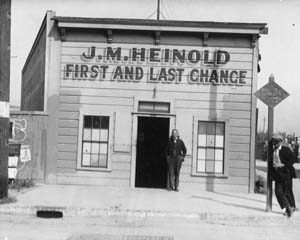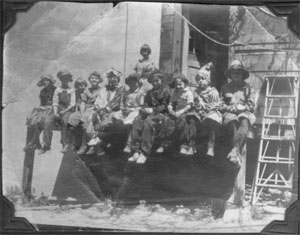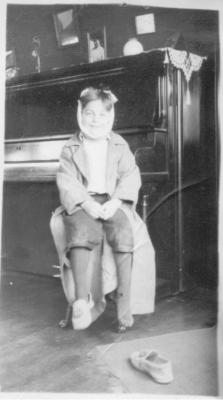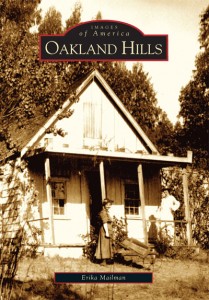Your first and last chance to be scared
This first appeared in the Montclarion Sept. 9, 2001. Images courtesy of the Oakland History Room.
 Not only was Heinold’s First and Last Chance Saloon Jack London’s favorite haunt in life, it possibly still is now that he’s occupying a barstool on the Other Side.
Not only was Heinold’s First and Last Chance Saloon Jack London’s favorite haunt in life, it possibly still is now that he’s occupying a barstool on the Other Side.
This 1880 structure, so tiny that it once served as a bunkhouse for oyster men (and even then one imagines a snorer could be hit awake by simply stretching an arm from one bunk to the other), was reportedly built from the timbers of a whaling ship.
History is visceral here: When walking in, one immediately notes the sharp slant of the floor, caused by the 1906 earthquake. A clock which stopped at the time of the quake still displays the time as 5:18. Gas lamps (for which proprietor Carol Brookman is having more and more difficulty procuring chimneys and wicks) imbue the saloon with the soft glow of another century.
But that’s not all that remains.
“There is a spirit here,” says Brookman. “Who or what I don’t know. But it’s exciting and we like it.”
Brookman says she and a former employee once saw a “fleeting shadow” shaped like a man in a back area of the bar, although there is no window in that area to cast a shadow.
And twice she has heard footsteps in the bar, while she was alone and had locked herself in — footsteps so definitive and loud that she got out of her chair in the office to go look. “I’m not kidding you,” she says. “The footsteps didn’t sound like an old man’s footsteps, more like a younger person with a little more spring in their step.” She adds that the steps sounded like those from a man’s old-fashioned leather boots.
Manager Joe Ferrazzano has been plagued by a ghost who tends to drop things. He has heard what sounds like an entire case of beer being dropped when he was alone in the saloon, and a bottle cap mysteriously plummeting to the middle of a just-sweeped floor (Not very eerie to report, it was a Bud Lite cap.)
More significantly, the hat of Johnny Heinold (who first opened shop in 1883) came off the wall and was laying on the floor. “There’s no way it would fall off,” says Ferrazzano. “There was no breeze; the front doors were closed.”
And Ferrazzano and his son Vinnie were astonished one night, after closing and cleaning, to see that the two refrigerators, embedded in the original iceboxes, had their doors splayed wide open. “That was the freakiest, because there’s no way in hell those doors would have opened,” said Ferrazzano.
“We’re very strict about keeping those closed,” adds Brookman.
Ferrazzano believes he can identify the culprit: “It was Heinold. I’m pretty sure.” His reasoning: the fact that the ghost seems to be a beer lover.
Brookman seems to think the spirit might be one of the many patrons who passed through the bar throughout the years. She mentions that the back door once opened directly onto the water, and men were “shanghai’d” out that door. Shanghai’ing was the practice of kidnapping someone to serve as a sailor. Often, drunk men would wake up to find themselves on a vessel already underway on a two or three year voyage.
“If you misbehaved in here, there were always sea captains and people looking for men,” says Brookman. She added that the waterfront was once a very dangerous place where women never ventured, until about the 1920s or so.
Illustrious patrons who may have left some ectoplasm on site include Jack London, of course, President William Taft, Robert Louis Stevenson, Joaquin Miller, Ambrose Bierce and a name one may not recognize: Alexander McLean, who was the model for Wolf Larsen in Jack London’s “The Sea Wolf.”
Besides ghosts, the bar can boast that everything in it is original except the chairs. The tables came from a whaling ship. The copper beer traps, still extant, which once caught the runoff from the taps were regularly emptied and the contents given to delivery horses in troughs outside.
“It’s wonderful to have this in an urban area,” says Brookman. “You can’t even find something like this in Gold Country.”
The intriguing name comes from the fact that the bar is situated on the waterfront— naturally, the first and last chance to lift a jar on terra firma.
The saloon has some exciting news: As of Sept. 1, 2000 it was listed with the National Register of Historic Places.
So if one’s in search of a place to have a Halloween drink in an historic setting, head down to the waterfront. But keep an eye on your beverage: As Ferrazzano set down a drink in front of me a few weeks ago, he quipped “You better drink it fast — Heinold might drink it for you!”
Heinold’s First and Last Chance Saloon is at 56 Jack London Square, 510-839-6761. The saloon’s Web site is www.firstandlastchance.com and the national register Web site is www.cr.nsp.gov/nr.

 Not only was Heinold’s First and Last Chance Saloon Jack London’s favorite haunt in life, it possibly still is now that he’s occupying a barstool on the Other Side.
Not only was Heinold’s First and Last Chance Saloon Jack London’s favorite haunt in life, it possibly still is now that he’s occupying a barstool on the Other Side. The hills neighborhood of Glenview may seem like a fairly pleasant little area, but once violence here was so severe it made Gangs of New York look like Rebecca of Sunnybrook Farm. That’s right, gang warfare once rocked these placid streets.
The hills neighborhood of Glenview may seem like a fairly pleasant little area, but once violence here was so severe it made Gangs of New York look like Rebecca of Sunnybrook Farm. That’s right, gang warfare once rocked these placid streets. "They’d come over and raid us," Veirs told me. "I was the littlest one of the group and I’d climb into the crow’s nest (one of the treehouses he’d built) and they’d throw rocks at it."
"They’d come over and raid us," Veirs told me. "I was the littlest one of the group and I’d climb into the crow’s nest (one of the treehouses he’d built) and they’d throw rocks at it."